Once we had an idea of what we wanted to avoid, we focused on what to include. The Keep on the Borderlands is the classic adventure bundled with the 1981 D&D Basic Set. The locations and encounter scenarios introduced in that adventure have stood the test of time, with DMs still using them to run games today. With that in mind, we decided to focus on making the adventure the key component of the Starter Set. A good adventure sees use again and again.
Moreover, we wanted an adventure that was similar to Keep on the Borderlands, but a bit more focused on helping new DMs launch campaigns. The original Keep is almost completely open-ended, but feedback during the playtest told us that some new DMs felt lost when figuring out exactly where to take an open-ended adventure. We wanted an adventure with a bit of direction to launch a campaign, which could then segue to a more open-ended approach after a play group has a couple of game sessions under its belt.
The result is Lost Mine of Phandelver. Weighing in at sixty-four pages, it provides enough material to advance characters up to 5th level. The first segment of the adventure puts DMs through the basics of asking for checks and saving throws, as the characters venture into a goblin lair on a rescue mission. Once the adventurers have dealt with the goblins, they have free reign to explore the region around the village of Phandalin. Three more dungeons and five other adventure locations provide novice DMs with plenty of material to keep a campaign going for months. With Basic D&D as a natural next step, DMs will have the tools they need to further expand the region and keep the action going.
We’ll talk about Lost Mine of Phandelver in more detail next week. The adventure’s author, Rich Baker, has graciously agreed to answer a few questions about the process of creating it.
In addition to Lost Mine of Phandelver, the Starter Set also includes a rulebook. This provides the basic rules of play, descriptions of the spells used by the pregenerated characters and NPCs, and the magic items found in the adventure. In addition, it makes a handy table reference for things like equipment and combat rules, and we expect that DMs who move on to Basic D&D or the three core rulebooks will continue to use the Starter Set rulebook as an extra resource during play.
The adventure comes with five pregenerated characters—a dwarf cleric, two human fighters, an elf wizard, and a halfling rogue. One of the fighters uses a large axe and heavy armor. The other is an archer clad in leather armor. Since the fighter is easily the most popular class in the game, we decided to offer two takes on it rather than a fifth character class. This approach also makes it easy for players to modify the pregenerated characters using Basic D&D, and to advance them past 5th level.
Finally, the Starter Set comes with a set of six polyhedral dice—marbled blue in color with white numbers. I have three of these sets in my dice bag—all early samples sent over by the factory. If you’ve watched our live stream games, you might have seen them in use.












![Glory to Codexia! [2012] Codex 2012](/forums/smiles/campaign_tags/campaign_slushfund2012.png)



![The Year of Incline [2014] Codex 2014](/forums/smiles/campaign_tags/campaign_incline2014.png)




![Have Many Potato [2013] Codex 2013](/forums/smiles/campaign_tags/campaign_potato2013.png)















